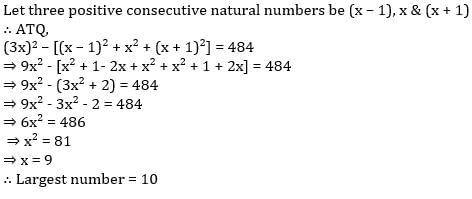Teaching Exam > Teaching Questions > If the square of sum of three positive consec...
Start Learning for Free
If the square of sum of three positive consecutive natural numbers exceeds the sum of their corresponding squares by 484 then what is the largest of the three numbers?
- a)7
- b)8
- c)9
- d)10
Correct answer is option 'D'. Can you explain this answer?
Verified Answer
If the square of sum of three positive consecutive natural numbers exc...

Most Upvoted Answer
If the square of sum of three positive consecutive natural numbers exc...
Given Information:
- Let the three consecutive natural numbers be x, x+1, and x+2.
Given Condition:
- The square of the sum of the three numbers exceeds the sum of their squares by 484.
Formulas:
- Sum of the three numbers: x + x+1 + x+2 = 3x + 3
- Square of the sum of the three numbers: (3x + 3)^2
- Sum of their squares: x^2 + (x+1)^2 + (x+2)^2
Equation:
- (3x + 3)^2 = x^2 + (x+1)^2 + (x+2)^2 + 484
Solve the Equation:
- Expand the left side: 9x^2 + 18x + 9 = x^2 + x^2 + 2x + 1 + x^2 + 4x + 4 + 484
- Simplify: 9x^2 + 18x + 9 = 3x^2 + 6x + 489
- Rearrange: 6x^2 + 12x - 480 = 0
- Divide by 6: x^2 + 2x - 80 = 0
- Factorize: (x + 10)(x - 8) = 0
- The possible values for x are -10 and 8. Since the numbers are positive, x = 8.
Calculate the Largest Number:
- Largest number = x + 2 = 8 + 2 = 10
Therefore, the largest of the three numbers is 10. Hence, the correct answer is option 'D'.
- Let the three consecutive natural numbers be x, x+1, and x+2.
Given Condition:
- The square of the sum of the three numbers exceeds the sum of their squares by 484.
Formulas:
- Sum of the three numbers: x + x+1 + x+2 = 3x + 3
- Square of the sum of the three numbers: (3x + 3)^2
- Sum of their squares: x^2 + (x+1)^2 + (x+2)^2
Equation:
- (3x + 3)^2 = x^2 + (x+1)^2 + (x+2)^2 + 484
Solve the Equation:
- Expand the left side: 9x^2 + 18x + 9 = x^2 + x^2 + 2x + 1 + x^2 + 4x + 4 + 484
- Simplify: 9x^2 + 18x + 9 = 3x^2 + 6x + 489
- Rearrange: 6x^2 + 12x - 480 = 0
- Divide by 6: x^2 + 2x - 80 = 0
- Factorize: (x + 10)(x - 8) = 0
- The possible values for x are -10 and 8. Since the numbers are positive, x = 8.
Calculate the Largest Number:
- Largest number = x + 2 = 8 + 2 = 10
Therefore, the largest of the three numbers is 10. Hence, the correct answer is option 'D'.

|
Explore Courses for Teaching exam
|

|
Question Description
If the square of sum of three positive consecutive natural numbers exceeds the sum of their corresponding squares by 484 then what is the largest of the three numbers?a)7b)8c)9d)10Correct answer is option 'D'. Can you explain this answer? for Teaching 2025 is part of Teaching preparation. The Question and answers have been prepared according to the Teaching exam syllabus. Information about If the square of sum of three positive consecutive natural numbers exceeds the sum of their corresponding squares by 484 then what is the largest of the three numbers?a)7b)8c)9d)10Correct answer is option 'D'. Can you explain this answer? covers all topics & solutions for Teaching 2025 Exam. Find important definitions, questions, meanings, examples, exercises and tests below for If the square of sum of three positive consecutive natural numbers exceeds the sum of their corresponding squares by 484 then what is the largest of the three numbers?a)7b)8c)9d)10Correct answer is option 'D'. Can you explain this answer?.
If the square of sum of three positive consecutive natural numbers exceeds the sum of their corresponding squares by 484 then what is the largest of the three numbers?a)7b)8c)9d)10Correct answer is option 'D'. Can you explain this answer? for Teaching 2025 is part of Teaching preparation. The Question and answers have been prepared according to the Teaching exam syllabus. Information about If the square of sum of three positive consecutive natural numbers exceeds the sum of their corresponding squares by 484 then what is the largest of the three numbers?a)7b)8c)9d)10Correct answer is option 'D'. Can you explain this answer? covers all topics & solutions for Teaching 2025 Exam. Find important definitions, questions, meanings, examples, exercises and tests below for If the square of sum of three positive consecutive natural numbers exceeds the sum of their corresponding squares by 484 then what is the largest of the three numbers?a)7b)8c)9d)10Correct answer is option 'D'. Can you explain this answer?.
Solutions for If the square of sum of three positive consecutive natural numbers exceeds the sum of their corresponding squares by 484 then what is the largest of the three numbers?a)7b)8c)9d)10Correct answer is option 'D'. Can you explain this answer? in English & in Hindi are available as part of our courses for Teaching.
Download more important topics, notes, lectures and mock test series for Teaching Exam by signing up for free.
Here you can find the meaning of If the square of sum of three positive consecutive natural numbers exceeds the sum of their corresponding squares by 484 then what is the largest of the three numbers?a)7b)8c)9d)10Correct answer is option 'D'. Can you explain this answer? defined & explained in the simplest way possible. Besides giving the explanation of
If the square of sum of three positive consecutive natural numbers exceeds the sum of their corresponding squares by 484 then what is the largest of the three numbers?a)7b)8c)9d)10Correct answer is option 'D'. Can you explain this answer?, a detailed solution for If the square of sum of three positive consecutive natural numbers exceeds the sum of their corresponding squares by 484 then what is the largest of the three numbers?a)7b)8c)9d)10Correct answer is option 'D'. Can you explain this answer? has been provided alongside types of If the square of sum of three positive consecutive natural numbers exceeds the sum of their corresponding squares by 484 then what is the largest of the three numbers?a)7b)8c)9d)10Correct answer is option 'D'. Can you explain this answer? theory, EduRev gives you an
ample number of questions to practice If the square of sum of three positive consecutive natural numbers exceeds the sum of their corresponding squares by 484 then what is the largest of the three numbers?a)7b)8c)9d)10Correct answer is option 'D'. Can you explain this answer? tests, examples and also practice Teaching tests.

|
Explore Courses for Teaching exam
|

|
Signup for Free!
Signup to see your scores go up within 7 days! Learn & Practice with 1000+ FREE Notes, Videos & Tests.























